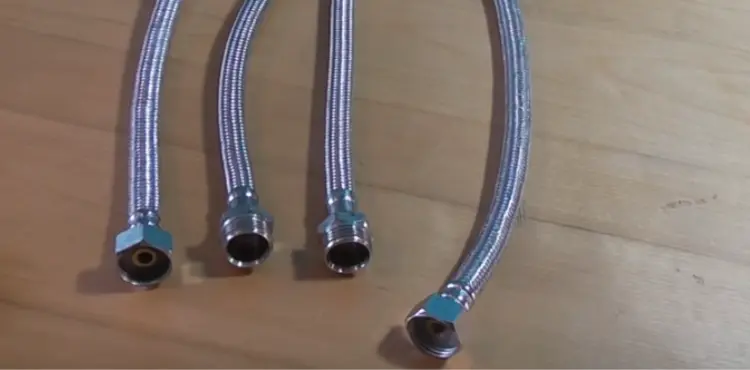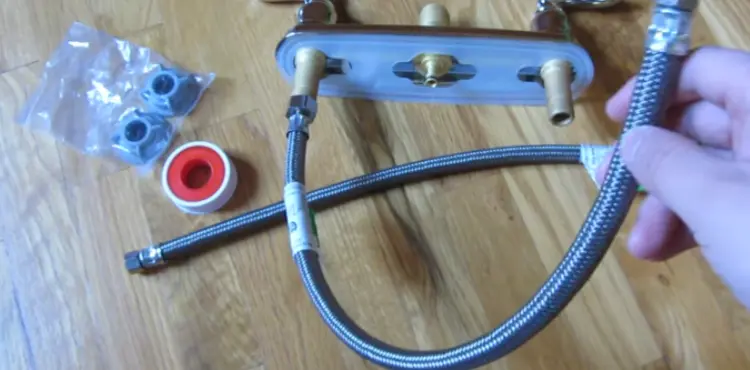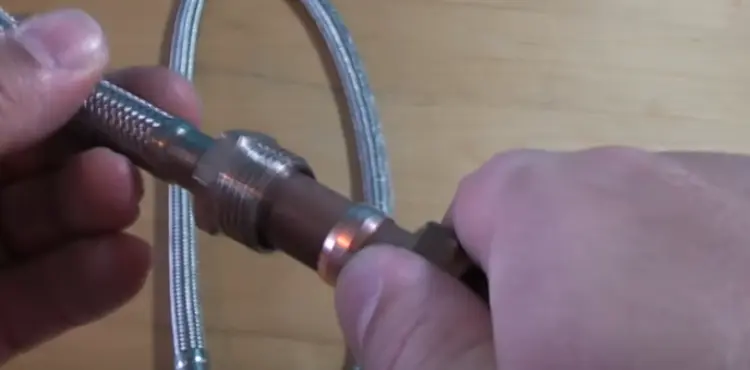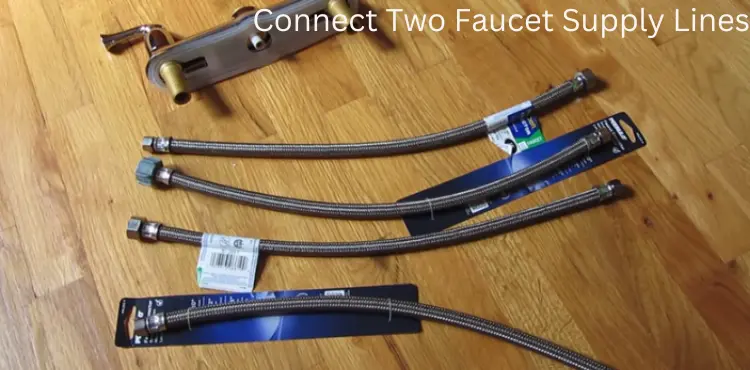The best way to connect two faucet supply lines together is, To connect two faucet supply lines together, you have to tighten up the nut connected with the threaded outlet, shutoff valve, and the faucet tailpiece. But now, the task has got easier with the compression fitting.
It is a type of coupling nut used to secure the connections between the shutoff valve, faucet tailpiece, and the brass compression ring.
When you begin the process, you have to first slide the compression nut, then slide the compression ring, place the ends, bend the tube, and so on. All these steps will seem confusing now. So it’s better to have a glimpse of these steps more precisely.
In this article, we will go through all the terms and steps that you will need to follow while connecting your two faucet supply lines together. So let us not make any further delay and get to the concept now.
Keep reading!

Tools And Costs For Connecting The Two Faucet Supply Lines
Before you start connecting the two faucet supply lines, make sure you have the basin wrench in your hand. This will help you to remove faucets, install faucets, and tighten up the nuts.
Its long handles will allow access to all those hard to reach places located under the sinks. Meanwhile, most of the work can be done using your hand’s strength.
Well, a basin wrench can cost you around $10 to $20.
Other materials that you may need to buy are- a tube, a compression nut, a faucet locking nut, a ring, and a faucet. Excluding the faucet, all the materials can cost you around $150. Whereas, only the faucet can cost you $100 to $400.
How To Connect Two Faucet Supply Lines Together? (5 Main Ways)

To know how to connect two water supply lines together, you must go through the following steps below:
Turn The Water Supply Off:
First thing first, you will have to turn the water supply off so that the water pressure does not bother you while connecting the faucet lines.
Besides, it can cause a loss of water. So after you turn the water supply off, drain out the lines into a big bowl or bucket.
And we know that water pressure makes the connecting process harder by showering water on us. If possible, use some safety gloves and goggles.
Keep The Tools Ready:
In this step, we will discuss which tool to use and where. Firstly, you have to locate the locking nut, ring, and compression fitting at the end of the supply lines.
Unless you connect the tubes, keep them in a safe place. While measuring the diameter of the lines, use the compression fitting properly.
It will require periodic maintenance. But it is prone to leakages and not so durable. If your concern is getting the job done, a compression fitting is not bad for that.
You will get the supplies easily at the local hardware stores and plumber supply stores.
Measure The Water Supply Lines:
Next, you will have to measure the distance between the shutoff valve and the faucet. You will find these sections beneath the sink.
After measuring, add four or five inches with the length, it depends on what type of water supply lines you have. This will give a good angle and flexibility to your room.
Use the supply lines wisely as they don’t come for free. If you see that your supply line is a bit shorter, grab a supply line extension. However, this supply line extension won’t cause any problems in your faucet supply lines.
Bend The Tubing:
Bend the tubing in such a way that its two ends form a nice angle. But don’t bend the two end sides of the tube as they need to link up.
After forming a connection between the valve, faucet, and supply lines, make sure you have attached their link with Teflon tape or plumber’s tape.
The compression fitting is reliable for the inflexible water supply lines. Like- copper tubes and plastic tubes. If your supply line is like that, you just need to push the fittings in your supply lines and connect them with a compression fitting.
Sometimes the line of hot water takes up the line of cold water and vice versa. To prevent that, keep the lines of hot water and cold water at least six inches away from each other. This step would be helpful if you don’t have an insulated hot water supply line.
Place The Faucet:

In the final step, you have to place the faucet at any one end of the faucet. Tighten up the nuts on that end where you have placed the faucet. And then connect the second end with the shutoff valve.
You can use a basin wrench to tighten this up. Another best alternative as said before would be Teflon tape. You can use it to wrap the threaded end after the installation.
By keeping the shutoff valve in its place, twist the faucet compression fitting with a screw. Your main concern should be connecting up the wall’s supply lines, not getting it too tightened.
Just make sure to connect your faucet enough firmly so that no leaks occur, don’t tighten it up too hard. Or else, your supply lines can get damaged.
When you will be using a wrench for a half-quarter turn, turn the water supply on. As a result, you can identify if there are any leaks in the water supply.
Frequently Asked Questions
How To Connect An Existing Water Line?
To connect a new drain or supply line with an existing line, you can simply install a tee fitting. This is easy to do. Just shut off the water associated with the existing water line or pipe.
In simple words, you have to run the pipe, support the pipe, place the tee assembly, and cut a new pipe.
How Tight Should A Supply Line Be?
Tighten up your supply line in such a way that it can flow to your home smoothly. In that case, a hand tight is okay. You can understand the construction and configuration of your water pipe.
It is meant to be hand-tight. Don’t tighten it up too hard so that it becomes difficult for the water to flow.
Should I Use Teflon Tape on My Faucet Supply Lines?
Teflon tapes are used to lubricate and seal the threaded pipe joints. This tape is also known as the plumber’s tape. If you see, maximum faucets have their hot and cold water lines attached. To connect them together, Teflon tape can be a handy alternative.
What Is The Common Method of Joining Pipes?
The most common method of joining a pipe is a butt weld. You will see, many plumbers use this butt weld method to connect pipes of the same measurement and diameter. This method is used widely in many industrial and commercial pipe systems.
How Much Te Is Needed To Connect Two Faucet Supply Lines Together?
To connect two faucet supply lines together, you will require 15 to 30 minutes. It can depend on how much you are used to plumbing activities.
For instance, if it’s your first time, you may need more than 30 minutes. Whereas, fixing the line by a plumber will take less than 15 minutes.
Final Thoughts
So this was all about the process of connecting the two faucet supply lines together. Yet, it would be better if we discuss the steps in brief again.
Firstly, you have to turn off the water supply line, drain the lines out, identify the hot and cold water supply lines, install the faucet, connect the compression fittings, turn on the water supplies, check the leaks, and you are done.
Make sure not to tighten up the nuts too hard. They should be hand tightened so that water can flow easily. It can happen that your task has gone wrong somewhere and you see certain leaks in the supply lines. Don’t get stressed at that time, and take help from a plumber.
Hopefully, the above article was helpful enough for you. Let us know through the comment section below if you have any queries.
Thank you.

Hi, this is Sondip. In my opinion, the best approach to making the most of your home is to clean it, decorate it, and organize it. You should feel most at ease in your own home.
If you considering changing your faucets or wanting to repair the ones you already have could find my enthusiasm and my ideas to be of enormous help. My aim is to assist you in selecting the ideal faucet, and accessories for your residence and ensure that they are compatible with your sink and worktops.

